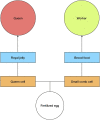Revising the Superorganism: An Organizational Approach to Complex Eusociality
- PMID: 31849768
- PMCID: PMC6901679
- DOI: 10.3389/fpsyg.2019.02653
Revising the Superorganism: An Organizational Approach to Complex Eusociality
Abstract
Eusociality is broadly defined as: colonies consisting of overlapping generations, cooperative brood care, and a reproductive division of labor where sterile (or non-reproductive) workers help the reproductive members. Colonies of many complex eusocial insect species (e.g., ants, bees, termites) exhibit traits, at the collective level, that are more analogous to biological individuals rather than to groups. Indeed, due to this, colonies of the most complex species are typically a unit of selection, which has led many authors to once again apply the concept of the superorganism to eusocial insects. However, unlike Wheeler, who originally employed the concept from a physiological and evolutionary perspective, today the superorganism is typically understood only from an evolutionary perspective, using group selection. This is because of the widely held view that eusocial colonies are self-organized systems. According to this view, even the most complex eusocial systems can be explained by appealing to a set of local interactions between parts of an initially disordered system (i.e., self-organization), without the need of any hierarchical control. In this paper, we challenge the mainstream view that hierarchical control and regulation does not occur, or is not necessary, in complex eusocial colonies. Using a case study of honey bees (Apis mellifera), we develop an alternative to the self-organization approach that focuses on the hierarchical nature of the organization of complex eusocial systems-that we refer to as the hierarchical-organizational approach. In addition, we analyze how colonies of eusocial insects show a complex set of interactions between the different organisms that bring forth a new cohesive collective organization, and how in turn the constitutive entities of this collective organization are transformed in this process. This paper argues that an inter-identity (namely the superorganism) emerges at the collective level in complex eusocial colonies, such as honey bees, due to the hierarchically organized network of interactions within the colony.
Keywords: eusociality; hierarchical regulation; inter-identity; self-organization; superorganism.
Copyright © 2019 Canciani, Arnellos and Moreno.
Figures


References
-
- Archer M. E. (1972). The significance of worker size in the seasonal development of the wasps Vespula vulgaris (L.) and Vespula germanica (F.). J. Entomol. 46, 175–183.
-
- Arnellos A. (2018). “From organizations of processes to organisms and other biological individuals” in Everything flows: Towards a processual philosophy of biology. eds. Nicholson D., Dupré J. (Oxford: Oxford University Press; ), 199–221.
LinkOut - more resources
Full Text Sources

